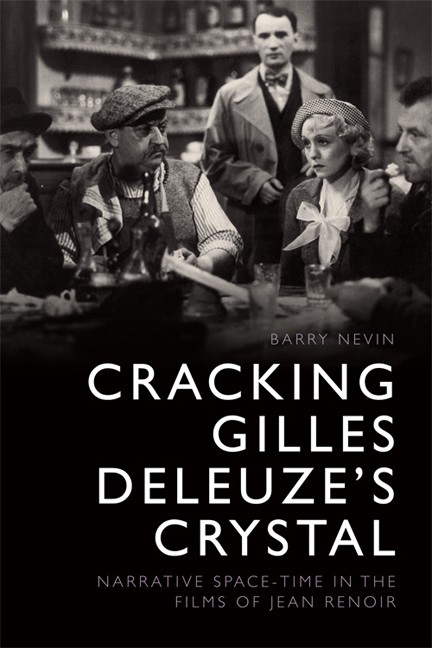Book contents
- Frontmatter
- Contents
- List of Figures
- Notes on Style
- Acknowledgements
- Preface
- Introduction
- 1 Theatrum Mundi: Framing Urban Dynamics in Renoir's Paris
- 2 From Desert to Dreamscape: Viewing Renoir's Rural Landscapes as Spatial Arenas
- 3 Portraying the Future(s) of the Front Populaire
- 4 Renoir's Crises Anti-Réalistes: Framing le Temps Gelé
- Conclusion
- Appendix: Corpus Breakdown
- Notes
- References
- Film Index
- General Subject Index
Introduction
Published online by Cambridge University Press: 01 May 2021
- Frontmatter
- Contents
- List of Figures
- Notes on Style
- Acknowledgements
- Preface
- Introduction
- 1 Theatrum Mundi: Framing Urban Dynamics in Renoir's Paris
- 2 From Desert to Dreamscape: Viewing Renoir's Rural Landscapes as Spatial Arenas
- 3 Portraying the Future(s) of the Front Populaire
- 4 Renoir's Crises Anti-Réalistes: Framing le Temps Gelé
- Conclusion
- Appendix: Corpus Breakdown
- Notes
- References
- Film Index
- General Subject Index
Summary
It is Renoir who had an acute awareness of the identity of liberty with a collective or individual future, with a surge towards the future, an opening of the future.
– Gilles DeleuzeThe space presented to the spectator is as movable as the spectator […]. Not only do solid bodies move in space, but space itself moves, changing, turning, dissolving and recrystallizing.
– Erwin PanofskyJean Renoir: l’exception glorieuse
André Bazin's landmark article, ‘L’Évolution du langage cinématographique’ (‘The Evolution of the Language of Cinema’, first published in 1958), retrospectively argues that Renoir alone held ‘the secret of a cinematographic narrative capable of expressing everything without chopping the world up, of revealing the hidden meanings of people and things without interfering with their natural unity’. For Bazin, Renoir's tendency to avoid montage in favour of deploying a mobile camera, deep space, and an ongoing dialectic between on-screen and off-screen space, elevated the cinema towards a closer ontological engagement with reality and, by extension, fulfilled what Bazin perceived as the seventh art's core vocation.
Renoir's work exemplifies Bazin's criteria to the extent that the theorist consecrated an entire book, Jean Renoir (published posthumously in 1971), to the director's body of work. Although Bazin's texts continue to exert a salient influence on studies of Renoir's narrative style, scholars are still catching up with Bazin's vision of the ‘hidden things’ revealed by Renoir's preservation of continuity in space and time. This concern constitutes the core question posed by this book. A comprehensive examination of the relationship between space and time in Renoir's films demands an analysis of two key facets of Renoir's work that have proven crucial, either individually or in combination, to virtually all critical studies of Renoir's oeuvre to date.
The first of these is Renoir's lucid dissection of social hierarchies, most notably class barriers, through a variety of motifs including costume design, speech, décor, and theatrical etiquette. Renoir writes in his autobiography:
When a French farmer finds himself eating at the same table as a French financier, these two Frenchmen have nothing to say to each other. One is entirely indifferent to what interests the other. But if we imagine a meeting between our French farmer and a Chinese farmer, they will have lots to tell one another.
- Type
- Chapter
- Information
- Cracking Gilles Deleuze's CrystalNarrative Space-time in the Films of Jean Renoir, pp. 1 - 28Publisher: Edinburgh University PressPrint publication year: 2018



